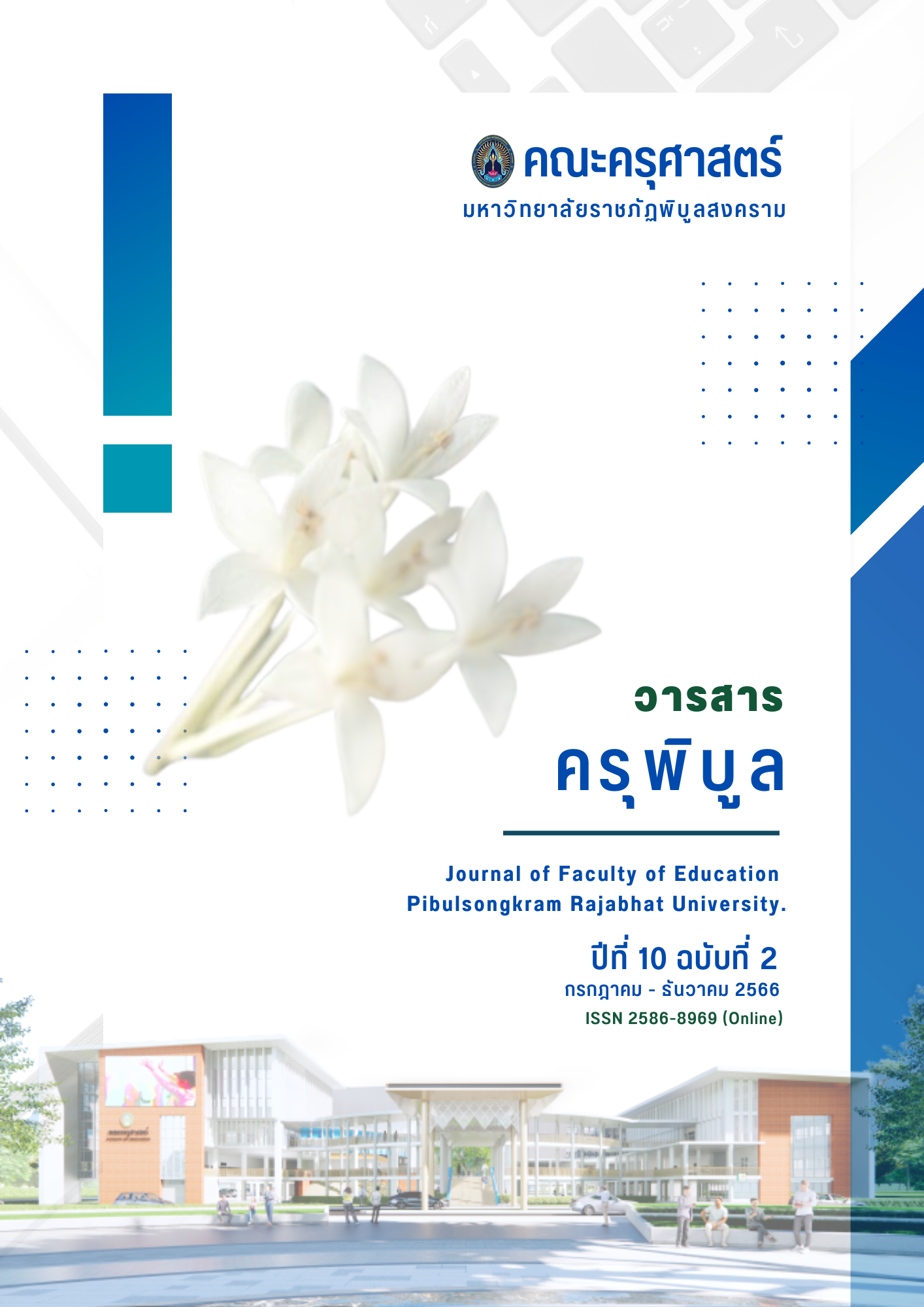ENHANCING STUDENT TEACHER’S ABILITY TO DESIGN ACTIVE LEARNING INSTRUCTIONS THROUGH ACTIVE LEARNING ACTIVITIES
Keywords:
ability to design active learning instructions, active learning activities, student teachersAbstract
This study aimed to achieve three objectives: 1) investigate the understanding of the student teachers in designing active learning instructions before and after their engagement in active learning activities; 2) assess the ability of the student teachers to design active learning instructions before and after their participation in active learning activities; and 3) explore the attitudes of the student teachers toward active learning activities. The study included 28 purposefully selected second-year student teachers from the general science education program. Research tools consisted of a lesson plan, a test on understanding in designing active learning instructions of the student teachers, an assessment form evaluating the student teacher’s ability to design active learning instructions, and a questionnaire probing the student teacher’s attitudes toward active learning instructions. Data analysis involved statistical methods along with percentage, average, and standard deviation.
The results revealed that:
1. the student teachers' overall understanding in designing active learning instructions increased by 65.19% after the intervention.
2. the student teachers' ability to design active learning instructions was consistently at a high level.
3. the student teachers displayed an exceptionally positive attitude toward active learning activities.
References
กระทรวงศึกษาธิการ. (2551). หลักสูตรแกนกลางการศึกษาขั้นพื้นฐานพุทธศักราช 2551. โรงพิมพ์ชุมนุมสหกรณ์การเกษตรแห่งประเทศไทย.
ข้อบังคับคุรุสภา ว่าด้วยมาตรฐานวิชาชีพ ฉบับที่ 4 พ.ศ. 2562. (2561, 19 เมษายน). ราชกิจจานุเบกษา. เล่ม 136 ตอนพิเศษที่ 68 ง. หน้า 19-20.
ชนาธิป พรกุล. (2551). การออกแบบการสอนการบูรณาการอ่าน การคิดวิเคราะห์และการเขียน. วีพริ้นท์ (1991).
ทิศนา แขมมณี. (2553). ศาสตร์การสอน องค์ความรู้เพื่อการจัดกระบวนการเรียนรู้ที่มีประสิทธิภาพ. สำนักพิมพ์แห่งจุฬาลงกรณ์มหาวิทยาลัย.
เทียมจันทร์ พานิชย์ผลินไชย. (2548). สถิติเพื่อการวิจัย. ภาควิชาการศึกษา มหาวิทยาลัยนเรศวร.
นนทลี พรธาดาวิทย์. (2559). การจัดการเรียนรู้แบบ Active Learning. ทริปเพิ้ลเอ็ดดูเคชั่น.
__________. (2560). การพัฒนาการจัดการเรียนรู้เชิงรุกในวิชาการจัดการเรียนรู้. วารสารวิจัย มทร.กรุงเทพ, 11(1), 85-94.
บัณฑิต ฉัตรวิโรจน์. (2550). การพัฒนารูปแบบการจัดการเรียนการสอนแบบการจัดการความรู้เพื่อเสริมสร้างสมรรถนะการสอนของนักศึกษาครู [วิทยานิพนธ์ปริญญาดุษฎีบัณฑิต]. จุฬาลงกรณ์มหาวิทยาลัย
บุญชม ศรีสะอาด. (2546). การวิจัยสำหรับครู. สุวีริยาสาส์น.
__________. (2556). วิธีการทางสถิติสำหรับการวิจัย (พิมพ์ครั้งที่ 5). สุวีริยาสาส์น.
พิมพันธ์ เดชะคุปต์ และพเยาว์ ยินดีสุข. (2561). การเรียนรู้เชิงรุกแบบรวมพลังกับ PLC เพื่อการพัฒนา. สำนักพิมพ์แห่งจุฬาลงกรณ์มหาวิทยาลัย.
เพ็ญพนอ พ่วงแพ. (2562). การพัฒนารูปแบบการเรียนการสอนเพื่อส่งเสริมสมรรถนะการออกแบบกิจกรรมการเรียนรู้สังคมศึกษา สำหรับนักเรียนนักศึกษาวิชาชีพครู [วิทยานิพนธ์ปริญญาดุษฎีบัณฑิต]. มหาวิทยาลัยศิลปากร.
รัตนะ บัวสนธ์. (2552). วิจัยเชิงคุณภาพทางการศึกษา. จุฬาลงกรณ์มหาวิทยาลัย.
สัญญา ภัทรากร. (2552). ผลของการจัดการเรียนรู้อย่างมีชีวิตชีวาที่มีต่อความสามารถในการแก้ปัญหาและการสื่อสารทางคณิตศาสตร์ของนักเรียนชั้นมัธยมศึกษาปีที่ 3 เรื่อง ความน่าจะเป็น [วิทยานิพนธ์ ปริญญาการศึกษามหาบัณฑิต]. มหาวิทยาลัยศรีนครินทรวิโรฒ.
สํานักงานคณะกรรมการการศึกษาขั้นพื้นฐาน. (2562). แนวทางการนิเทศเพื่อพัฒนาและส่งเสริมการจัดการเรียนรู้เชิงรุก (Active Learning) ตามนโยบายลดเวลาเรียน เพิ่มเวลารู้. หน่วยศึกษานิเทศก์ สํานักงานคณะกรรมการการศึกษาขั้นพื้นฐาน.
สำนักงานเลขาธิการสภาการศึกษา. (2563). การจัดการเรียนรู้ฐานสมรรถนะเชิงรุก. 21 เซ็นจูรี่.
Bonwell, C. C., & Eison, J. A. (1991). Active Learning: Creating Excitement in the Classroom. ERIC Clearinghouse on Higher Education. George Washington University.
Dick, W., Carey, L., & Carey, J. O. (2015). The systematic design of instruction. (8th ed.). The Pearson eText With Loos-Leaf Version – Acces Card Package.
Meyers, C. & Jones, T. B. (1993). Promoting Active Learning: Strategies for The College Classroom. Jossey-Bass.
Morrison, G. R., Ross, S. M., & Kemp, J. E. (2011). Designing Effective Instruction (6th ed.). Hoboken, NJ.: John Wiley & Sons.
Richey, R. C., Klein, J. D., & Tracy, M. W. (2011). The lnstructional Design Knowledge Base. Taylor & Francis.
Silberman, M. (1996). Active Learning. Bacon.
Downloads
Published
Issue
Section
License
Copyright (c) 2023 คณะครุศาสตร์ มหาวิทยาลัยราชภัฏพิบูลสงคราม

This work is licensed under a Creative Commons Attribution-NonCommercial-NoDerivatives 4.0 International License.
ลิขสิทธิ์เป็นของคณะครุศาสตร์ มหาวิทยาลัยราชภัฏพิบูลสงคราม


